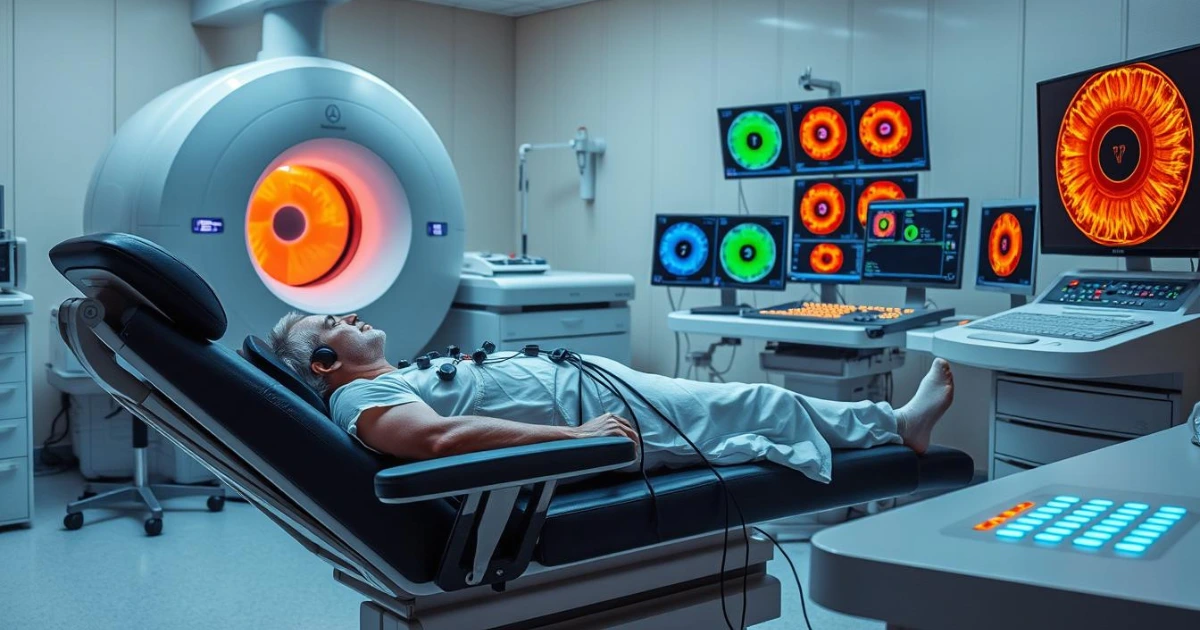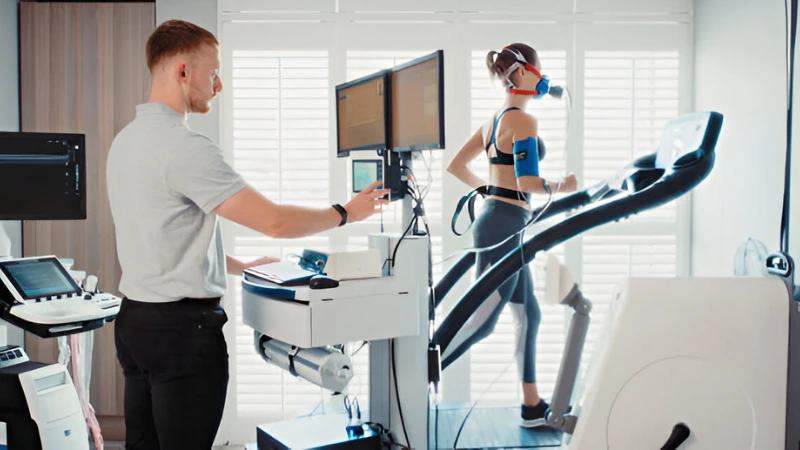What is a Lexiscan Nuclear Stress Test and How Does It Work?
Table of Contents
A Lexiscan nuclear stress test is a special test for the heart. It uses a drug called Lexiscan and nuclear imaging to check blood flow. It’s great for people who can’t do hard exercise.
For this test, a tiny bit of radioactive tracer is put into your blood. It goes to your heart and is seen by cameras. The Lexiscan drug makes your heart work like it does during exercise.
Then, the cameras take pictures of your heart. These pictures show if there are any problems with blood flow. Your doctor can see these pictures to find out what’s going on with your heart.
Key Takeaways
- A Lexiscan nuclear stress test is a special heart test. It uses a drug and nuclear imaging to check blood flow.
- This test is great for people who can’t do hard exercise during a regular stress test.
- The Lexiscan drug makes your heart work hard, like during exercise. A radioactive tracer is used to see the heart’s blood flow.
- The nuclear imaging technology lets doctors see if there are any problems with blood flow in the heart.
- The Lexiscan nuclear stress test can help find and check many heart problems, like coronary artery disease and heart muscle issues.
Understanding Lexiscan Nuclear Stress Testing Basics
Lexiscan nuclear stress testing is a special heart check. It doesn’t need you to exercise like regular stress tests do. Instead, it uses Lexiscan to make your heart work hard, just like exercise would.
Key Components of the Test
The Lexiscan nuclear stress test has three main parts:
- The stress agent, Lexiscan, makes your blood vessels open up and your heart beat faster, just like exercise.
- A radioactive tracer is injected into your blood. It goes to your heart muscle, letting doctors see it clearly.
- Special imaging equipment, like a gamma camera or PET scanner, takes pictures of your heart’s blood flow.
How Lexiscan Differs from Traditional Stress Tests
Lexiscan nuclear stress tests and traditional exercise stress tests work differently. Exercise tests make you run on a treadmill or bike. But Lexiscan tests use a medicine to make your heart work hard, which is great for people who can’t exercise.
The Role of Nuclear Imaging
The nuclear imaging part of the Lexiscan test shows detailed pictures of your heart’s blood flow. Doctors use these pictures to find out if your heart muscle is getting enough blood. This is important because it can show early signs of heart disease or blockages.
By using Lexiscan and nuclear imaging together, doctors can really understand your heart health. They can then decide the best treatment for you, if needed.
Why Your Doctor Might Recommend a Lexiscan Nuclear Stress Test
If you’re having heart issues or your doctor wants to check your heart’s health, they might suggest a Lexiscan nuclear stress test. This test gives important details about how well your heart works and spots any problems.
Doctors often suggest this test for heart conditions like coronary artery disease. It’s great for people who can’t do a regular exercise stress test because of health issues or physical limits.
This test looks at blood flow to your heart when you’re stressed. It helps find blockages or areas where blood flow is low. Knowing this is key to figuring out how serious heart problems are and what treatment you need.
Also, it’s used to see if treatments like procedures or medicines are working. The Lexiscan nuclear stress test gives a detailed look at your heart’s performance. This helps your doctor make the best decisions for your cardiac evaluation and care.
“The Lexiscan nuclear stress test is a powerful diagnostic tool that can provide valuable insights into the health of your heart, even if you’re unable to exercise.”
Preparing for Your Nuclear Stress Test
Getting ready for a nuclear stress test is key for good results. Whether it’s a Lexiscan test or a traditional cardiac test, there are important steps to take. These steps help make the test go well and give your doctor the best info about your heart.
Dietary Restrictions Before the Test
Before the test, you might need to skip caffeine and some medicines for 24-48 hours. These can mess with the test’s accuracy. You’ll also likely need to fast for a few hours before the test.
Medication Adjustments
- Talk to your doctor about changing or stopping medicines that could skew the test.
- Have a list ready of all your medicines, including prescriptions and supplements.
What to Bring on Test Day
On test day, don’t forget to bring:
- Your current medicines list
- Comfortable, loose clothes
- Any important medical records or test results
By following these steps, you can make sure your nuclear stress test is a success. It will give your doctor the best info about your heart health.
The Step-by-Step Process of a Lexiscan Nuclear Stress Test
Getting a Lexiscan nuclear stress test is key to knowing your heart’s health. It’s a detailed process that uses a radioactive tracer and nuclear imaging. This helps check how well your heart works. Let’s explore the steps you’ll go through during this lexiscan procedure and nuclear imaging process.
The test usually lasts 3-4 hours, with breaks in between scans. You’ll stay awake and be watched by doctors. Here’s what happens:
- Injection of the Radioactive Tracer: First, a small amount of radioactive tracer is given through a vein. This tracer goes to your heart muscle.
- Resting Images: Then, you’ll have the first scans while resting. These images show how your heart works normally.
- Administration of Lexiscan: Next, you’ll get Lexiscan through an IV. It makes your blood vessels wider, like exercise does for your heart.
- Stress Images: After Lexiscan takes effect, you’ll have more scans. These show how your heart acts under stress.
By comparing the resting and stress images, doctors get a full picture of your heart. This helps them spot any problems or concerns.
Remember, the Lexiscan nuclear stress test is safe and widely used. Your healthcare team will help you through it all. Knowing about the lexiscan procedure and nuclear imaging process makes you more ready for your test.
Understanding Nuclear Stress Test Side Effects and Safety
Lexiscan nuclear stress tests are usually safe. But, there are some side effects and safety points to know. This knowledge helps you feel more ready for the test.
Common Side Effects
Common side effects include shortness of breath, headaches, flushing, and nausea. These usually go away soon after the test. But, serious reactions like abnormal heart rhythms or allergic reactions are rare.
Safety Measures During Testing
Doctors watch your vital signs and symptoms closely during the nuclear stress test. They use the least amount of radioactive tracer needed. This keeps your radiation exposure low. Also, the latest imaging tech helps use even less radiation.
Long-term Considerations
Though there’s some radiation in a nuclear stress test, the long-term risks are small. The test’s benefits usually outweigh the risks. But, people with certain health issues or past radiation exposure should talk to their doctor about long-term effects.
So, is a nuclear stress test dangerous? No, thanks to modern safety steps and careful watching, most patients face little risk. Knowing about side effects and safety helps you feel more at ease for your Lexiscan test.
Duration and Recovery Time Expectations
Understanding the duration and recovery time for a Lexiscan nuclear stress test is key. It helps you prepare and know what to expect.
The test usually takes 3-4 hours from start to finish. This includes getting ready, taking the Lexiscan, and the imaging. The actual test part is quick, but the whole time is needed for monitoring and data.
You can usually go back to your daily activities right after. But, it’s best to have someone drive you home. You might feel some side effects like flushing, headache, or dizziness for a bit.
| Metric | Average Duration |
|---|---|
| Nuclear Stress Test Duration | 3-4 hours |
| Recovery Time | Immediate, with possible short-term side effects |
Talk to your healthcare provider about any worries or questions. They can give you advice based on your health and the test’s purpose.
“The key to a successful Lexiscan nuclear stress test is being well-informed and prepared. Knowing what to expect in terms of duration and recovery can help make the process smoother for you.”
Interpreting Your Nuclear Stress Test Results
Understanding your nuclear stress test results is key to knowing your heart’s health. These tests show how well blood flows to your heart. This helps doctors spot any heart problems.
Reading Nuclear Images
The test takes pictures of your heart at rest and when you’re stressed. Doctors look at these images to see if blood flow is okay. If it’s not, it could mean heart disease or other issues.
The results are usually normal, abnormal, or unclear. If it’s abnormal, it means your heart might not be getting enough blood. This could be due to a blockage or other heart problems.
Understanding Test Scores
- Normal results mean your heart gets enough blood flow at rest and when stressed.
- Abnormal results show your heart isn’t getting enough blood. This could mean a blockage or heart issue.
- Inconclusive results mean the test didn’t give a clear picture of your heart’s function. More tests might be needed.
Your doctor will look closely at your nuclear stress test results and cardiac imaging interpretation. They’ll decide what to do next. This could be more tests, changes to your treatment, or keeping an eye on your heart health.
| Test Result | Interpretation | Next Steps |
|---|---|---|
| Normal | Sufficient blood flow to the heart during rest and stress | Continued monitoring, potentially no further testing required |
| Abnormal | Reduced blood flow to one or more areas of the heart | Additional testing, treatment options, ongoing monitoring |
| Inconclusive | Unable to provide a clear picture of heart function | Further testing, such as a different imaging modality |
Talking about your nuclear stress test results and cardiac imaging interpretation with your doctor is important. It helps you understand your heart health and get the right treatment.
Alternative Testing Options to Consider
Lexiscan nuclear stress tests are great for checking heart health. But, there are other tests that might work better for you. Your doctor will pick the best test based on your health and how active you can be.
Some common alternatives to Lexiscan nuclear stress tests include:
- Traditional exercise stress tests: These tests check how your heart does during exercise, often on a treadmill or stationary bike.
- Stress echocardiograms: This test uses ultrasound to see how well your heart pumps blood when you’re active.
- Cardiac CT scans: These scans give detailed pictures of your heart’s structure and function without needing surgery.
The right test depends on your health, risk factors, and what your doctor needs to diagnose you. It’s key to talk to your doctor about all your options. This way, you get the best care for your heart.
| Cardiac Testing Alternative | Key Features |
|---|---|
| Traditional Exercise Stress Test | Measures heart’s response to physical activity using treadmill or stationary bike |
| Stress Echocardiogram | Uses ultrasound imaging to evaluate heart function during exercise |
| Cardiac CT Scan | Provides detailed images of heart structure and function without invasive procedures |
Remember, your doctor knows best when it comes to choosing a test for you. By working together, you can get the best care for your heart.
Cost and Insurance Coverage for Nuclear Stress Tests
The cost of a Lexiscan nuclear stress test can change a lot. It depends on where you live and who your healthcare provider is. This test is often needed, but it can be expensive. Knowing the usual costs and what your insurance covers is key to handling the costs.
Average Testing Costs
A nuclear stress test can cost between $1,500 and $5,000. The average is about $2,500. But, costs can vary. This is due to the testing place, where you live, and any extra tests or images needed. Always ask your healthcare provider for a precise cost for you.
Insurance Requirements
- Most big medical insurance plans cover nuclear stress tests if your doctor says it’s needed.
- But, you might still have to pay some costs. This could be deductibles, copays, or coinsurance, based on your plan.
- It’s smart to call your insurance before getting the test. Ask about any special rules or limits for nuclear stress test cost and cardiac test insurance coverage.
| Insurance Provider | Nuclear Stress Test Coverage | Typical Out-of-Pocket Costs |
|---|---|---|
| Medicare | Covered when medically necessary | 20% of the Medicare-approved amount after the deductible |
| Aetna | Covered with prior authorization | Varies based on your plan’s deductible and coinsurance |
| Blue Cross Blue Shield | Covered when medically necessary | Depends on your specific plan benefits |
Knowing the usual costs and what your insurance covers helps. It prepares you for the money side of a Lexiscan nuclear stress test. It also helps you get the care you need while keeping costs in check.
When to Seek Emergency Care After the Test
Complications from Lexiscan nuclear stress tests are rare. But, knowing the warning signs is key. Severe chest pain, long-lasting dizziness, or trouble breathing are serious signs. They might mean you need to see a doctor right away.
If you see any of these post-test complications or cardiac emergency signs, get help fast:
- Severe, persistent chest pain or discomfort
- Shortness of breath or difficulty breathing
- Prolonged dizziness, lightheadedness, or fainting
- Irregular or rapid heartbeat
- Swelling, pain, or redness at the injection site
These symptoms could mean a bad reaction to Lexiscan or a heart problem. If you notice them, call 911 or get someone to take you to the emergency room. Don’t wait.
| Symptom | Potential Cause | Action to Take |
|---|---|---|
| Severe chest pain | Heart attack or other cardiac event | Seek emergency medical care immediately |
| Difficulty breathing | Allergic reaction or respiratory distress | Seek emergency medical care immediately |
| Persistent dizziness | Low blood pressure or other cardiovascular issue | Seek emergency medical care immediately |
Your health and safety are the most important things. If you feel bad after your Lexiscan test, get help right away.
“Early recognition and treatment of post-test complications are crucial for ensuring the best possible outcomes for patients.”
Conclusion
Lexiscan nuclear stress tests are key in heart health checks. They help doctors understand how well your heart works and blood flows. This knowledge is crucial for making the right treatment plans for you.
Knowing the lexiscan nuclear stress test benefits and its cardiac diagnostic importance can boost your confidence. It shows how important it is for keeping your heart safe.
If you’re getting a Lexiscan test, knowing what to expect is important. It’s also good to know the risks and what it can reveal about your heart. Working closely with your doctor and being involved in your care is key.
This way, you make sure the test gives you the most useful information. It helps you understand your heart health better.
Lexiscan tests are a big help in heart care. By using them, you’re taking a big step towards keeping your heart healthy for a long time.
FAQ
What is a Lexiscan Nuclear Stress Test and How Does It Work?
A Lexiscan nuclear stress test is a special heart imaging test. It uses a medicine called Lexiscan and nuclear imaging to check blood flow to the heart. This test is great for people who can’t do exercise tests.
What Are the Key Components of a Lexiscan Nuclear Stress Test?
A Lexiscan test has three parts: Lexiscan, a radioactive tracer, and imaging tools. Unlike regular tests, Lexiscan doesn’t need exercise. It uses nuclear imaging to show blood flow to the heart, helping find blockages.
How Does a Lexiscan Nuclear Stress Test Differ from Traditional Stress Tests?
A Lexiscan test uses medicine to mimic exercise, not actual exercise. This is good for people who can’t exercise because of health or physical reasons.
What is the Role of Nuclear Imaging in a Lexiscan Nuclear Stress Test?
Nuclear imaging shows blood flow to the heart at rest and when stressed. Doctors use this to find heart problems like coronary artery disease.
Why Might My Doctor Recommend a Lexiscan Nuclear Stress Test?
Doctors might suggest this test for heart issues, to check heart problems’ severity, or to see if treatments worked. It’s especially helpful for those who can’t exercise.
How Should I Prepare for a Lexiscan Nuclear Stress Test?
Preparation is key for good test results. Avoid caffeine and some medicines 24-48 hours before. You might need to fast for hours. Bring your medicines, comfy clothes, and medical records.
What is the Step-by-Step Process of a Lexiscan Nuclear Stress Test?
The test involves steps like injecting a tracer and giving Lexiscan. You’ll have two scans: one at rest and one under stress. It takes 3-4 hours, with breaks in between. You’ll stay awake and be watched the whole time.
What Are the Potential Side Effects and Safety Considerations of a Nuclear Stress Test?
Lexiscan tests are mostly safe but might cause shortness of breath, headaches, or flushing. Rare but serious reactions can happen. Safety steps include watching you closely and using the least amount of radioactive tracer needed. The risk of long-term harm from radiation is low for most people.
How Long Does a Lexiscan Nuclear Stress Test Take, and What is the Recovery Time?
A Lexiscan test usually takes 3-4 hours. You can go back to normal activities right after. But, it’s best to have someone drive you home because some side effects might last a bit.
How Are the Results of a Nuclear Stress Test Interpreted?
The test shows blood flow to the heart at rest and stress. Doctors look for areas with less blood flow, which could mean blockages or heart issues. Results are usually normal, abnormal, or unclear, with more details about specific areas of concern.
What Alternative Cardiac Testing Options Are Available?
Lexiscan tests are useful, but other tests might be better in some cases. These include exercise stress tests, stress echocardiograms, or cardiac CT scans. Your doctor will choose the best test for you based on your health and ability to exercise.
What is the Cost of a Lexiscan Nuclear Stress Test, and Does Insurance Cover It?
The cost of a Lexiscan test varies by location and facility. Many insurance plans cover it when it’s needed for medical reasons. You might still have to pay for copays or deductibles. Check with your insurance to see if it’s covered and if you need to get approval first.
When Should I Seek Emergency Care After a Lexiscan Nuclear Stress Test?
While rare, serious problems can happen after a test. If you have severe chest pain, can’t stop dizziness, or have trouble breathing, get help right away. These could be signs of a serious heart problem that needs quick attention.







